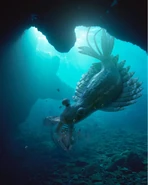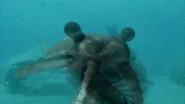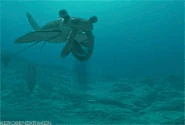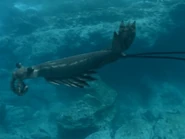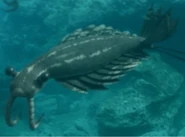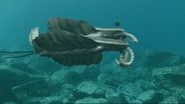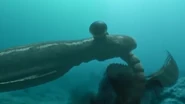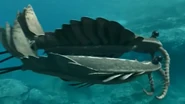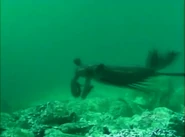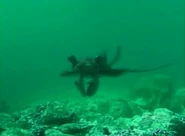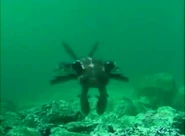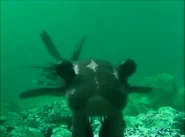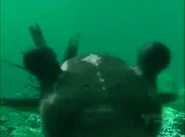| “ | This is Anomalocaris - Earth's first superpredator! | ” |
– Kenneth Branagh | ||
Anomalocaris was an arthropod-like sea monster and the largest of its family, Anomalocaridida.
Facts[]
Earth’s first super predators, these mighty, spineless, two-meter-long monsters owed their success to a monumental, evolutionary land mark: Their eyes. These eyes may have looked bizarre, but they were not unique. Many other predators during the Anomalocaris time had also evolved eyes, and so did their prey.
Anomalocaris was one of the most successful animals of the Cambrian period; it had a worldwide distribution and survived over 20 million years. Not only that, but Anomalocaris is also noteworthy for evolving compound eyes independently of trilobites (who made their eyes from calcite). Anomalocaris' eyes, on the caliber of only a few modern insects, were compound with around 30 thousand lenses. He would swim above the ocean floor, find prey, and shred it in three rings of teeth. Anomalocaris is known to have eaten trilobites, as indicated by bite marks in his prey of the right size and shape; trilobite remnants in Anomalocaris droppings also have been found.
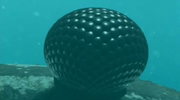
Anomalocaris eye (Water Dwellers)
Appearances in the programmes[]
Walking with Monsters[]
Water Dwellers[]
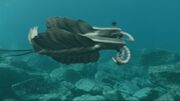
Two Anomalocaris dueling. (Water Dwellers)
Anomalocaris (more specifically, the Chinese "tailed" Anomalocaris saron) features in the first half of Water Dwellers. In that episode, Anomalocaris is initially depicted finding a trilobite (a first-person view is even shown for a few seconds) and proceeding to grab it with its "great appendages", rocking it back and forth, and then eating it once its meal's armor splits. Two Anomalocaris then get into a fight for reasons unspecified, wounding one and breaking his armor (see below). The wounded Anomalocaris then is discovered and eaten by a school of Haikouichthys. Then the Narrator says that Haikouichthys is our ancestor and Haikouichthys evolves into a jawless fish called Cephalaspis.
Trivia[]
- Upon its initial discovery in 1912, Anomalocaris was believed to be multiple animals; its front appendages were believed to be the hinder halves of shrimp ("strange" because their "head" was always missing), its mouth was believed a jellyfish, and his body a sea cucumber or a sponge. This mistake was only realized in the 1980s, providing the modern reconstruction as the half a meter-long flippered monster.
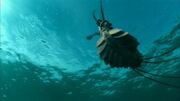
An Anomalocaris being defeated (Water Dwellers)
- Despite its name, Anomalocaris was not closely related to shrimp. It is a stem-group arthropod, and thus not related to crustaceans. It is also said to be related to velvet worms, but this is also erroneous.
- The portrayal of Anomalocaris in Walking with Monsters is based on holotype of Innovatiocaris maotianshanensis, a specimen about 15 centimeters in length (including the tail). It was previously considered a body fossil of Anomalocaris saron (now called Houcaris saron), known only for appendages, but, as of recently, has been denied as such. The maximum length of H. saron's appendages is about 20 cm, but its estimated total body length is about 50 cm. The shape of H. saron's body is unknown, so it cannot be said with certainty that it had a long tail.
- Also incorrect was the statement that Anomalocaris had "the very first eyes". This honor actually belongs to other arthropods that appeared in the early Cambrian.
- Due to how its feeding apparatus was structured (a small mouth opening, called an oral cone, with rows of inwards facing tooth plates), Anomalocaris would have been incapable of biting anything that didn't fit into its mouth, and thus it was unlikely to have attack something its own size.
- Since the carapace of trilobites are really hard, as they are made of calcite, both the oral cone and frontal appendage spines are not suitable for crushing through it. Therefore, Anomalocaris likely did not hunt benthic animals like trilobites, instead being a pelagic hunter that actively hunted swimming arthropods and other animals in the water column.
Gallery[]
References[]
|

